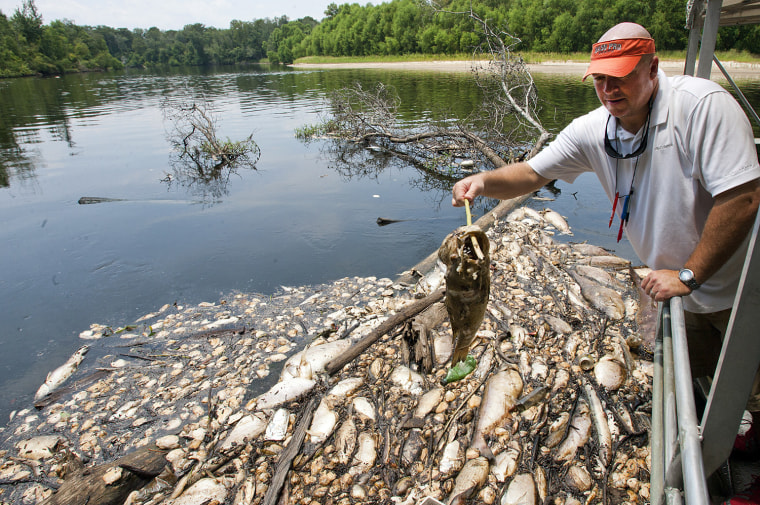A rotten stench hung over a 60-mile stretch of Louisiana's Pearl River as boats trawled through thick layers of hundreds of thousands of dead fish, and sweating workers bent to scoop the carcasses from the water.
The fish, including federally protected Gulf sturgeon as well as catfish and flounder, died after a paper mill in Bogalusa released a high concentration of waste material into the river on Aug. 9.
"This is really sickening," said St. Tammany Parish President Kevin Davis, unable to hide his disgust at the view from Crawford Landing, 40 miles northeast of New Orleans.
The liquid material, which mill owner Temple-Inland Inc. refers to as "black liquor," effectively sucked the oxygen from a large section of the river, killing every breathing organism within its reach, including the fish. Davis put the number of fish killed at hundreds of thousands.
More than 400 people worked from boats and the river banks over the weekend to clean up the river in 90-degree heat. By Monday, the water was nearly clear of carcasses, but a ban on fishing and swimming remained in place pending water testing.
Preliminary test results show water quality in the river had "improved dramatically" in the last few days, and there was no evidence toxins were released into the water, a state Department of Environmental Quality spokesman said on Friday.
"This was a biological problem, and not a chemical or toxic problem, which is encouraging," the department's environmental scientist Jeff Dauzat said, adding workers were still tallying the toll on fish and other river life.
But the wildlife damage was severe from a situation made worse by recent drought conditions. In addition to Gulf sturgeon, ringed sawback turtles and heelsplitter mussels were among the dead.
Slidell lawyer Tom Thornhill has filed a class action lawsuit in state court against Temple-Inland on behalf of owners of land and businesses affected by the discharge.
The incident at Temple-Inland, whose officers have apologized to state and local authorities for the discharge, began when managers noticed a problem with the plant's wastewater treatment system.
But the mill did not notify the Department of Environmental Quality of a problem until the evening of Aug. 13. According to Dauzat, by that time, officials were already looking into the fish kill after receiving calls from the media.
"That's how we found out about it," he said. "We didn't hear it from the company until eight hours later."
Temple-Inland's local spokesman, Jay Wilson, said managers took "mitigating actions" as soon as they noticed a problem. But he said it can take several days to get results of tests that help predict the release of an abnormal concentration of mill waste that comes from processing wood into paper.
He said Temple-Inland shut down the paper mill as soon as managers realized the plant might exceed the waste material concentration allowed under its state permit.
"We shut the facility down and made the notifications as required to our regulatory agencies," he said.
Officials say the damage was likely worsened by the low level of the Pearl River due to a drought. The low volume and slow flow of the water probably caused the black plume to linger longer than it would have in normal conditions.
As the plume, and dead fish, flowed further south to where the river empties into the Gulf of Mexico, the tide pushed some carcasses into surrounding waterways, including Lake Pontchartrain, which lies just north of New Orleans.
John Lopez, the acting director of the Lake Pontchartrain Basin Foundation, described the impact on the lake as "minimal or at least localized." But he said he was disturbed about the delayed warning of a dangerous situation.
"Frankly, this is the kind of behavior you would expect from an industrial plant 30 years ago," he said. "It's not how modern plants are run in terms of their contingency planning, monitoring and their response to the public."
The Department of Environmental Quality has said Temple-Inland agreed to pay for a new round of precautionary testing of private water wells along the river and of seafood from affected areas. Results were expected within days.
